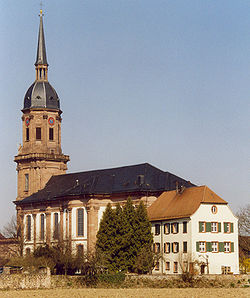Schuttern Abbey
| Imperial Abbey of Schuttern | ||||||||||
| Reichsabtei Schuttern | ||||||||||
| Imperial Abbey of the Holy Roman Empire | ||||||||||
|
||||||||||
| Capital | Schuttern Abbey | |||||||||
| Government | Theocracy | |||||||||
| Historical era |
High Middle Ages Early modern period |
|||||||||
| • | Founded by wandering monk (unattested) |
603 |
||||||||
| • | Schuttern Gospels created | 817 | ||||||||
| • | Granted Imp. immediacy by Emperor Otto II |
975 |
||||||||
| • | Joined Bursfelde Congregation |
1490–1623 |
||||||||
| • |
Secularised to Modena-Este by Treaty of Lunéville |
1801 |
||||||||
| • | Abbey held by the Knights of St John |
1803 |
||||||||
| • | Mediatised to Mgvt Baden by Peace of Pressburg |
1805 |
||||||||
| • | Dissolved | 1806 | ||||||||
|
||||||||||
| Today part of |
|
|||||||||
Schuttern Abbey (Reichsabtei Schuttern) was a Benedictine monastery in Schuttern (now part of the community of Friesenheim), Baden-Württemberg, Germany.
According to tradition, the monastery was founded in 603 by the wandering Irish monk Offo. After some initial difficulties the monastery and the settlement round it, at that time known as Offoniscella ("cell of Offo"), gradually flourished. In the 8th century Saint Pirmin introduced the Rule of St. Benedict and revived the fortunes of the abbey, as demonstrated by the rush of new postulants from the nobility at this period. Schuttern and some others, next only to Bamberg, were reckoned among the most significant Imperial abbeys in the country.
In 817 a Gospel Book (the Schuttern Gospels, now in the British Library in London), commissioned by the then Abbot Bertrich and written by the deacon Luithar witnesses among other works to the existence of a writing school of high quality in the abbey.
In 1016 the Emperor Henry II stopped at the abbey while returning to Frankfurt and visited the tomb of the founder Offo. The grave was covered by a precious mosaic showing Cain murdering Abel, which survives and can be claimed to be the oldest of its kind in Germany. The mosaic, although no longer entire, can now be seen in the church crypt.
Wars, lootings and arson were a frequent occurrence, and the abbey went up in flames on several occasions (938, 1153, 1166, 1169, 1240, 1334, 1520) but was always rebuilt.
On 6 May 1770 the abbey accommodated for a night the Archduchess Maria Antonia, the future Marie Antoinette, daughter of the Empress Maria Theresia, and her numerous retinue, on her way from Schloss Schönbrunn to Kehl, where on 7 May she was to be received by her future court before marrying the future Louis XVI of France.
...
Wikipedia

